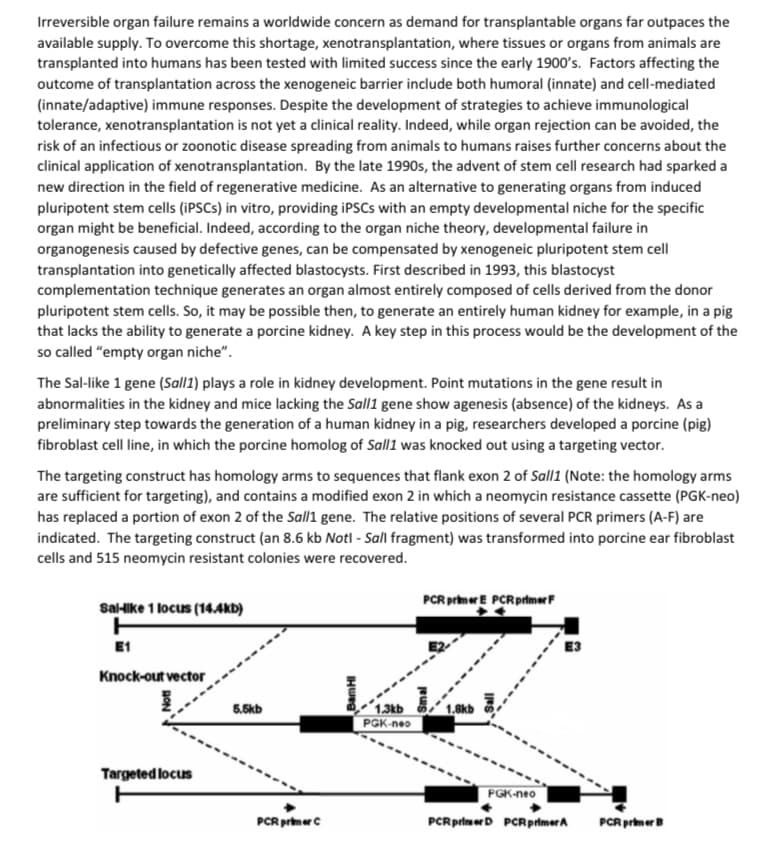The neomycin resistant colonies were screened by PCR using the primers A and B. Only seven of the 515 colonies (AB1 – AB7) resulted in the production of a PCR product of the expected size. The remaining 508 colonies failed to produce a PCR product (of any size). Explain why this would have been observed. Note: there is a rational explanation for this other than “the experiment did not work or there was a problem with the reagents”.
The neomycin resistant colonies were screened by PCR using the primers A and B. Only seven of the 515 colonies (AB1 – AB7) resulted in the production of a PCR product of the expected size. The remaining 508 colonies failed to produce a PCR product (of any size). Explain why this would have been observed. Note: there is a rational explanation for this other than “the experiment did not work or there was a problem with the reagents”.
Human Physiology: From Cells to Systems (MindTap Course List)
9th Edition
ISBN:9781285866932
Author:Lauralee Sherwood
Publisher:Lauralee Sherwood
Chapter12: Body Defenses
Section: Chapter Questions
Problem 1SQE
Related questions
Question
a) The neomycin resistant colonies were screened by PCR using the primers A and B. Only seven of the 515 colonies (AB1 – AB7) resulted in the production of a PCR product of the expected size. The remaining 508 colonies failed to produce a PCR product (of any size). Explain why this would have been observed. Note: there is a rational explanation for this other than “the experiment did not work or there was a problem with the reagents”.

Transcribed Image Text:Irreversible organ failure remains a worldwide concern as demand for transplantable organs far outpaces the
available supply. To overcome this shortage, xenotransplantation, where tissues or organs from animals are
transplanted into humans has been tested with limited success since the early 1900's. Factors affecting the
outcome of transplantation across the xenogeneic barrier include both humoral (innate) and cell-mediated
(innate/adaptive) immune responses. Despite the development of strategies to achieve immunological
tolerance, xenotransplantation is not yet a clinical reality. Indeed, while organ rejection can be avoided, the
risk of an infectious or zoonotic disease spreading from animals to humans raises further concerns about the
clinical application of xenotransplantation. By the late 1990s, the advent of stem cell research had sparked a
new direction in the field of regenerative medicine. As an alternative to generating organs from induced
pluripotent stem cells (iPSCS) in vitro, providing iPSCs with an empty developmental niche for the specific
organ might be beneficial. Indeed, according to the organ niche theory, developmental failure in
organogenesis caused by defective genes, can be compensated by xenogeneic pluripotent stem cell
transplantation into genetically affected blastocysts. First described in 1993, this blastocyst
complementation technique generates an organ almost entirely composed of cells derived from the donor
pluripotent stem cells. So, it may be possible then, to generate an entirely human kidney for example, in a pig
that lacks the ability to generate a porcine kidney. A key step in this process would be the development of the
so called "empty organ niche".
The Sal-like 1 gene (Sall1) plays a role in kidney development. Point mutations in the gene result in
abnormalities in the kidney and mice lacking the Sall1 gene show agenesis (absence) of the kidneys. As a
preliminary step towards the generation of a human kidney in a pig, researchers developed a porcine (pig)
fibroblast cell line, in which the porcine homolog of Sall1 was knocked out using a targeting vector.
The targeting construct has homology arms to sequences that flank exon 2 of Sall1 (Note: the homology arms
are sufficient for targeting), and contains a modified exon 2 in which a neomycin resistance cassette (PGK-neo)
has replaced a portion of exon 2 of the Sall1 gene. The relative positions of several PCR primers (A-F) are
indicated. The targeting construct (an 8.6 kb Notl - Sall fragment) was transformed into porcine ear fibroblast
cells and 515 neomycin resistant colonies were recovered.
Sal-like 1 locus (14.4kb)
E1
Knock-out vector
Targeted locus
5.5kb
PCR primer C
BamHI
1.3kb
PGK-neo
PCR primer E PCR primer F
1.8kb
Sall
PGK-neo
E3
PCR primerD PCR primer A
PCR primer B
Expert Solution
This question has been solved!
Explore an expertly crafted, step-by-step solution for a thorough understanding of key concepts.
Step by step
Solved in 3 steps

Knowledge Booster
Learn more about
Need a deep-dive on the concept behind this application? Look no further. Learn more about this topic, biology and related others by exploring similar questions and additional content below.Recommended textbooks for you

Human Physiology: From Cells to Systems (MindTap …
Biology
ISBN:
9781285866932
Author:
Lauralee Sherwood
Publisher:
Cengage Learning

Human Heredity: Principles and Issues (MindTap Co…
Biology
ISBN:
9781305251052
Author:
Michael Cummings
Publisher:
Cengage Learning

Human Physiology: From Cells to Systems (MindTap …
Biology
ISBN:
9781285866932
Author:
Lauralee Sherwood
Publisher:
Cengage Learning

Human Heredity: Principles and Issues (MindTap Co…
Biology
ISBN:
9781305251052
Author:
Michael Cummings
Publisher:
Cengage Learning